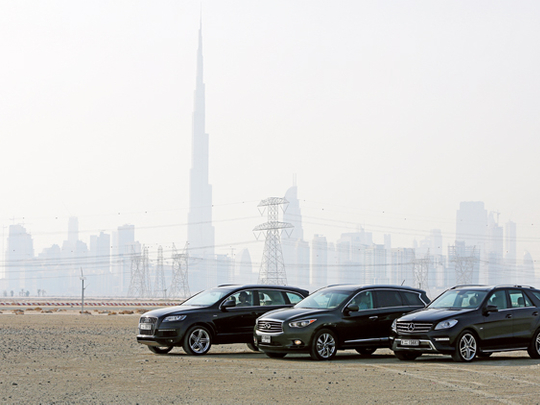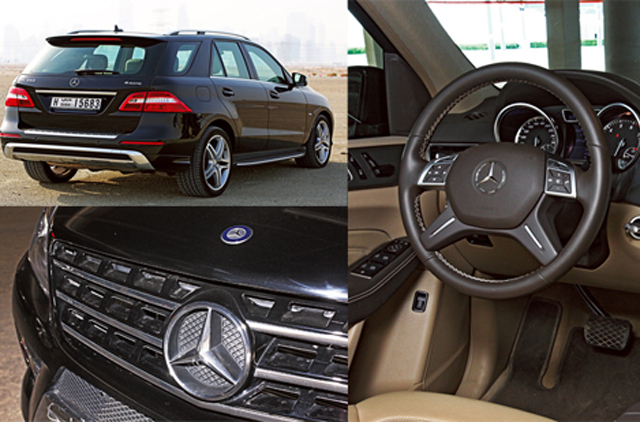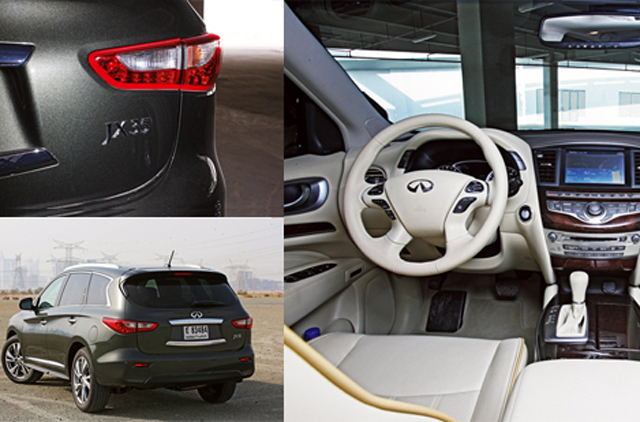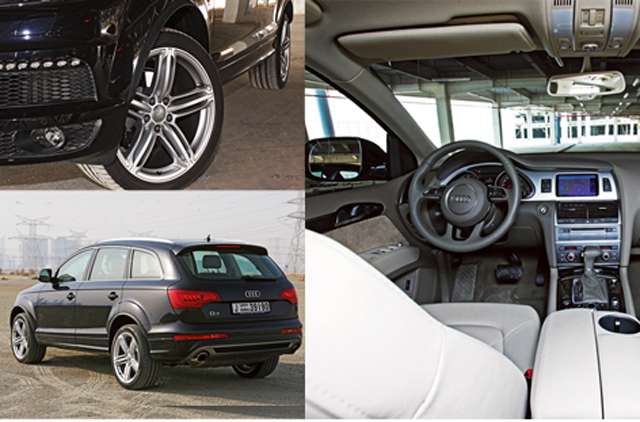
About 350 kilograms, 100mm, 23mm, and 15mm. That's how much heavier, and respectively longer, wider and taller the Audi Q7 is compared to the brand new Infiniti JX35 crossover. So why in the world are we pitting a heavyweight against a featherweight in what's clearly about to be a one-sided bloodbath?
Well don't look at us like that, like we're morons. It was in fact Infiniti's very own people who insisted that the JX35's closest and most formidable rival is, indeed, the Audi Q7. We choked on our fatayer at the crossover's local launch upon hearing that but then immediately realised that nobody else was laughing.
They're serious. So then we went and called the just-asnew Mercedes-Benz ML 350 to join in and sort of try to break up this pair if it gets too rough. There was surprise, there was disappointment, and there was only one winner in the end. And for once, it wasn't a Nissan GT-R.
Dejan's ML 350
The defining characteristic of the M-Class is that it drives like a car. You can electrically adjust your seat quite low, manually drop the steering wheel into your lap, and tootle along as if you were in a hatchback.
This is a very poised and leisurely feeling to have in an SUV, especially when you find out that everything, from the steady and straight braking composure to the minimal squat and dive during straight runs in the ML 350, mimics normal car behaviour.
But there is a problem, and it's all to do with the old "the bigger they are, the harder they fall” syndrome. And since the ML 350 weighs in at 2,150kg, that fall's going to hurt quite a bit. Stuttgart's recent spate of excellence — I loved all of the following in the last year or so: new C-Class, new SLK, C-Class Coupé, C63 AMG, any S-Class — may have raised my expectations too high.
The ML is slightly underwhelming inside, failing to elevate its cabin aura above the feeling you get even in a base C-Class. There is evidence of cost-cutting, and comparing some of the plastics to the stuff they source over in Ingolstadt and Munich is just not applicable here. Especially bad is a huge rolling cover for the cup holders, which is quite flimsy.
The digital gauges in the instrument binnacle are highly pixelated and nowhere near as bright and animated as the ones in the Infiniti, or as crisp as the Audi's display.
There is also no satellite navigation in our tester, and Mercedes will charge you for this optional extra. Satellite navigation simply has to be standard equipment in a large Mercedes-Benz — end of discussion.
Enough toys abound otherwise, but the car's On & Offroad Package, controlled by a knob on the centre console, is another omitted option in our tester. However there is a button controlling the blissful Airmatic suspension.
Although if you set it to sport, the body hunkers down and the suspension hardens, which is jarring over the road surface but keeps the car planted in the turns.
Comfort mode is considerably softer, and earns its name for the ability to cushion the ride. Even driving around like this, the ML behaves much more like a saloon car than its agricultural predecessor.
I don't see the point of a sport mode, since even these tasty AMG wheels and relatively low-profile tyres strike the perfect balance between safe dynamics and a comfortable ride quality.
Besides the plastic, life on the inside is pleasant and airy, aided by a huge twin sunroof, comfortable seats, and an excellent unhindered view. There is extra legroom in the rear compared to the old ML, but no third row seats.
One of my favourite features is the heated and cooled cupholders, which can toggle between scorching to icy in a matter of seconds. Sometimes you never know you need something until it's just there.
The ML 350 is a highly competent and handsome family hauler, typified by its car-like behaviour. But most surprisingly, I reserve the only real criticism for the 3.5-litre V6 engine, which I've gone on about many times before, touting it as one of the creamiest naturally aspirated V6s available today.
I shall now proceed to eat my words like a bowl of Alpha-Bits. Could you pass the skimmed milk, please? The engine is burdened with a lot of weight. It's rattly and uninspiring under full-throttle and tedious to listen to.
Don't get me wrong, the performance is great — 0-100kph in 7.6 seconds is perfectly fine — but mated to the inconspicuous seven- speed automatic, the V6 never once felt comfortable in its responsibility of behaving suitably for a Mercedes-Benz.
I'm just going to go out and say it, and trust me Daimler Middle East, this hurts me more than it hurts you. It felt like a four-pot… Could it be the fuel map? Was the run-in process botched? Speaking of botched, would you look at the styling on…
Sony's Infiniti JX35
Dejan doesn't know what he's talking about. A curve, according to Infiniti, is the perfect line. In that case, the Infiniti JX35 is a heck of a large perfect line. Right from the grille and the bonnet to the fenders and beltline, the JX is a carnival of curves.
Although some of these seem to have been put in there just for the sake of having them there, it must be admitted that the new Infiniti design language doesn't look as polarising as it does in the smaller FX or as downright revolting as in the gargantuan QX.
Moreover, the JX's curves do a pretty good job at concealing its substantial size.
And size is something that really matters when a potential customer in this segment makes a decision.
The JX fills a niche — that of a sevenseater crossover — in the Infiniti lineup that the carmaker thinks is a crucial one. The moment you step inside the roomy cabin, you realise that Infiniti has delivered on its promise of a true sevenseater.
The JX offers generous amounts of leg and headroom in the front and second row seats, while the third row seats are more than just ornamental. The cabin ergonomics are smartly designed to allow maximum flexibility.
With the second row seats sliding easily forward, getting in and out of the third row is no longer a pain. However, the back seats are still better suited for kids than for adults, especially for long trips.
If the three rows of seats and the luxuriously appointed interior don't prove deal-clinchers, then the staggering amount of standard safety and convenience features packed into the JX will.
Our test car came with remote engine start, intelligent cruise control, forward and back-up collision intervention, which not only alerts you but even brings the car to a complete halt if a possible collision is detected.
It feels creepy initially as the car stops itself at lights without you touching the brake pedal. It's a brilliant safety feature, but will take some getting used to.
Then there are the usual tricks that have come to be expected in high-end cars now, like a lane departure warning and prevention system, blind spot warning and a host of other driving assistance technologies.
Coming to the drivetrain, for some reason Infiniti chose to stick the old 3.5-litre V6 in there rather than the updated 3.7-litre unit.
Don't expect any kind of sportiness from this lump, even in Sport mode, which allows you to pretend it's a manual.
Although paired with a CVT gearbox it doesn't have the usual strained drone you'd expect to hear in such a setup. And thanks to the same platform that underpins the Maxima, the JX's handling is a lot better than other SUVs in Infiniti's line-up. Come to think of it, it's better even than…
Imran's Audi Q7
Not so fast. Granted, the JX is a good effort, but I still feel the Q7 is the daddy. Let's leave trivial details such as performance and handling aside for just a tad.
Why anyone wants to know this when talking about a large family hauler makes me wonder about people's mental health — I think they're mental.
What you need your seven-seat SUV to do is easily accommodate the entire family, pet dog and copious amounts of shopping bags with absolute ease.
The revised Q7 (or product improvement, in Audi speak) does all of that without braking a sweat, but then goes much, much further.
It has tonnes of room across its three rows, thanks to its luxurious 3,000mm wheelbase within an overall length of 5,090mm. It boasts a 735-litre cargo capacity, but drop the second and third rows and you get 2,035 litres.
They fold flat too, so you can squeeze in enough flat pack furniture to furnish an entire building. OK, you can't, but you get the idea. It has a towing capacity of 3,500kg— that's the equivalent weight of an Asian elephant! Impressed?
There's more. It's ever so practical, what with an electrically operated tailgate, and it's stuffed with some terrific equipment that comes as standard including speed sensitive servotronic steering, four-zone automatic air conditioning, electric seats with lumbar support, an MMI radio operating system complete with a CD and DVD player and a 1,000-watt advanced sound system from Bang & Olufsen with 14 speakers.
Our test car also had the Audi Parking System Advanced, with a rear view camera and parking sensors, not to mention satellite navigation, Bluetooth and a massive panoramic sunroof.
Parents will be pleased to read that it has rear side airbags and ISOFIX child seat preparation for the back chairs.
The words fully loaded spring to mind. Driving it is a breeze, especially with the Audi side assist working overtime monitoring your blind spots and ensuring safe lane changes above 30kph. The radar system detects the flow of traffic as far back as 70 metres behind the imposing and attractive Audi.
You really do have eyes in the back of your Q7. The exterior features a newly designed radiator grille, bumpers and new xenon headlights with LED daytime running lights at the front and back.
The 21" five-spoke alloys give it a sporty look, while all Q7s should be finished in the sharp Orca Black metallic paint that our car had.
Inside, it is elegant, light and airy, while the redesigned instrument panel encircled by metallic frames, makes, as Dejan pointed out, reading the dials easy.
The mood lights just add to the glamour quotient, as does the leather, aluminium and chrome trim. You can see why the Q7 is an attractive package and I wonder just how the new generation Q7, out in 2015, will top this. Finally, to the powerplant.
The new 3.0-litre TFSI Supercharged V6 is mated to an eight-speed automatic. It produces 333bhp, 440Nm of torque, and returns 10.7 litres-per-100km. Sure, the Q7 feels heavy and has some body roll, but soccer moms won't be redlining this handsome S line.
Oh, it hits 0-100kph in 6.9 seconds and has a top speed of 243kph. There, that should keep the mentalists happy.
Verdict
The ML gets everything right dynamically and it looks taut and well-proportioned as well. Compared to the bus-like Audi and the over-designed JX, the M-Class is just plain classy.
The problem is with its limited equipment level and seating, some interior materials and lacklustre performance from the V6, which feels far better under the bonnet of an SLK.
The mighty Audi Q7's engine is just delicious throughout the rev range, but it's seriously dated now and the staid interior design doesn't help things much. It's absolutely vast inside, although you'll be paying dearly for all that space with the Audi’s price.
That leaves us with the Infiniti, which, although cannot match its rivals' brand image, surprisingly fends off the two luxury Germans while oozing comfort from every one of its ill-styled pores.
It is comfortable, practical and boasts some properly decent kit, the softest leather, and an Oriental avant-garde interior design. With its attractive price, it simply has to do well in our market, even though it's the latest newcomer here.
Despite some shortcomings such as that annoying CVT, the new Infiniti JX is the daddy — which, mummy will probably drive the most.














